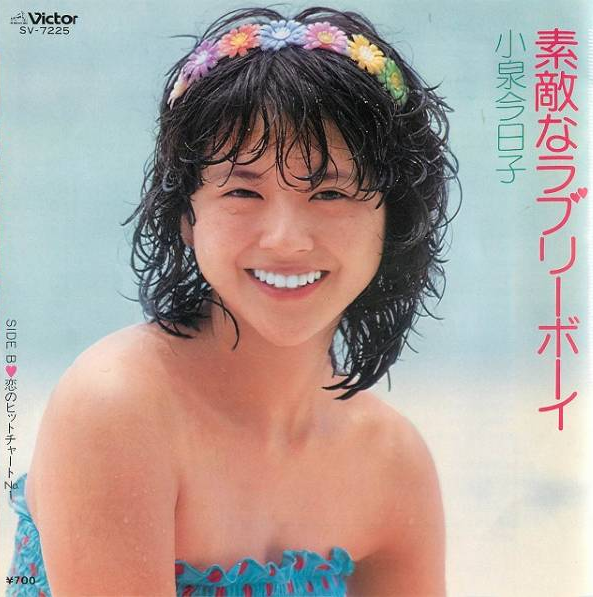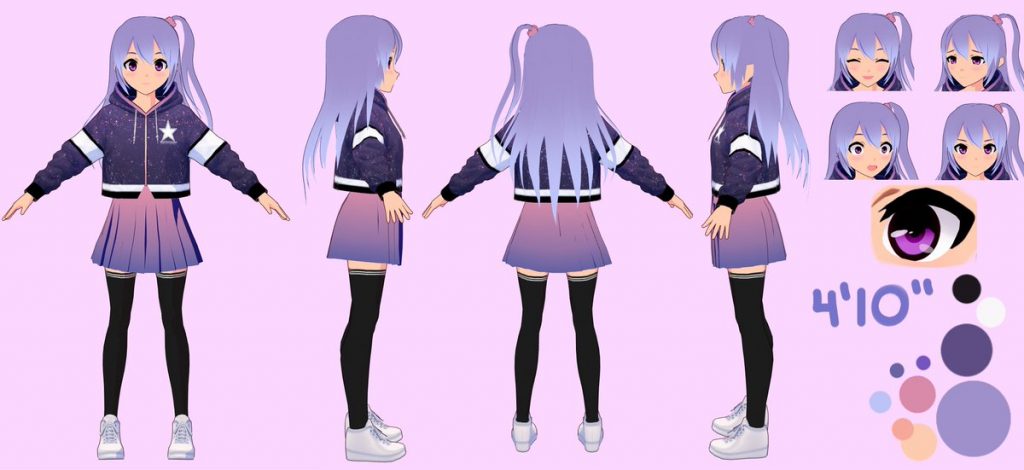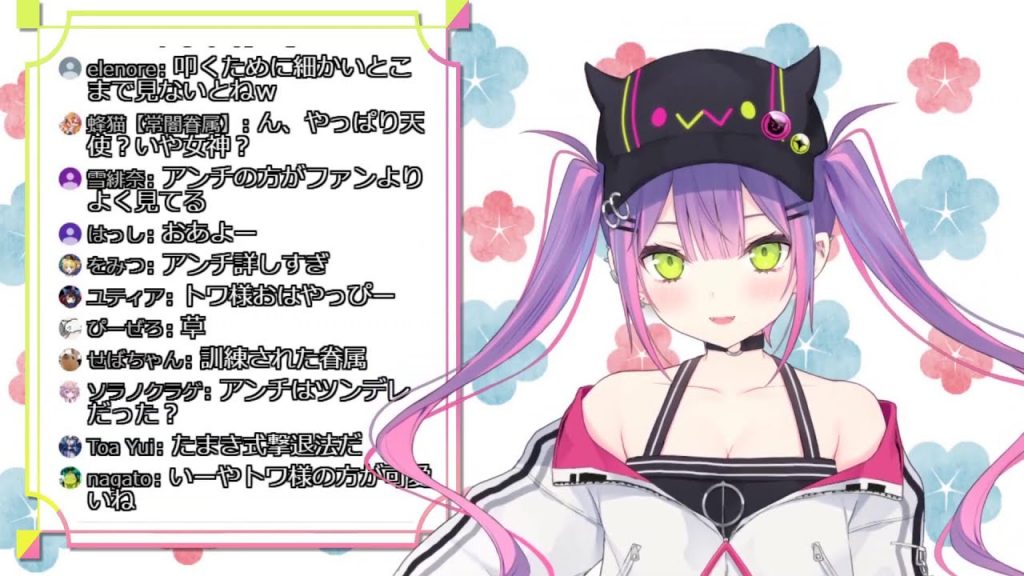We will be taking a look at the interesting new world of VTubers; online entertainers in YouTube videos or streams, usually portrayed by anime-inspired characters. Where do they come from, what do they do and what can we expect from them?
This image shows the way the popular YouTuber and streamer Pokimane decided to appear on her regular stream just two weeks ago. The event sparked quite some people to comment their opinions on the matter on social media. While most of them were sympathetic with her trying something new, another group was very vocal about their disapproval and even more ‘mainstream’ media picked up on it.
For those new to the 3D characters on streams and YouTube videos, Vtubers, or Virtual YouTubers, are online entertainers. They make YouTube video’s in which they sing, chat and loads more or appear in live streams, in the form of a digital persona, usually anime-based. VTubers are not strictly speaking ‘new phenomena’. In 2011 Ami Yamato, a UK-based Japanese Youtube Vlogger uploaded her first video in which she appeared as a 3D-animated character. Five years later Kizuna Al received credit for being the first ‘real’ Vtuber, and from this point onward Vtubers became increasingly popular. In Japan, these VTubers already made it big and they are now on the rise among more ‘western-based’ audiences. That’s why it is high time we take a look into this trend. Firstly I will place the phenomenon in a wider historical context. Secondly, we will take a look at how the origins influenced Vtubers and look at some recent developments in this subgenre. Lastly, we end by considering some Vtube achievements and glancing into future possibilities.
Historical roots: Japanese idol industry
Although Vtubers are relatively new, there is a longer-standing tradition in Japan, dating back to the ‘60s of the previous century for agency companies to create idols. The word idol, or aidoru in Japanese, is a widespread notion in the country and it basically is an entertainer that is specifically manufactured and marketed for image, attractiveness and personality. There are a few differences with ‘regular’ celebrities, but one of the main key features is that they endorsing talent agencies have aggressive control over not just the public images of their idols’ life, but also over their private lives, in order for them to maintain a strong bond with passionated audiences. The lives of non-virtual idols were portrayed in a very careful way to cater to fans and every aspect was rigorously controlled by their promoters.

Between the ’90s and ’00s these companies started to make their idols appeal to a specific demographic; young adult males, also known as ‘Otaku’, people with a specific interest in anime and manga. These corporations wanted the fanbases to be as dedicated as possible, as a way to bind fanbases to them and create loyal customers. This way they could sell more merchandise and simply make more money. In order to make their idols more appealing, some components of their lives became more important to regulate; specifically their datelife. Quite a number of these companies figured that an image of innocence and availability would be able to bind more fans to a specific idol, even going as far to include ‘date-clauses’ in their idols contracts, fining them for sometimes millions of yens when they broke the rules.
”The judge in that case, Akitomo Kojima, said: “The clause prohibiting dating was necessary to get the support of male fans. The revelation of an idol’s relationship damages their image.”

Now, what does this have to do with Vtubers? More than just one thing as it will turn out. In the first place, these existing practices made it logical for an agency company to establish itself with a focus on a new type of idol: Vtubers. Hololive is an agency created by Cover Corp and is currently one of the biggest Japanese VTuber agencies, founded in 2016 and, at the time of writing, has 3,5 million subscribers. They focus on live streaming their 3D anime-based characters, with content including singing, gaming and live chats with fans. From 2016 onwards they have steadily contracted new talents, referring to their ‘’generation’’ as an indication in what general periods they were recruited.
In a similar fashion as the older agencies, Hololive is also creating idols. Vtubers are persona, a character, with specific traits, preferences and gimmicks that are made to appeal to a certain audience. The agency merchandise their employees to the target audience and try to make them loyal customers of an idol. The majority of VTube characters are girls and innocence and purity still play the biggest role. However, there is a steadily growing market for the opposite of this character; the overly sexual or ‘lewd’ characters. While Hololive is also ‘creating’ idols, for now they appear to stay far away from harsh dating- clauses in their contracts and are quite supportive of their employees taking breaks when needed, meddling far less in their private lives.
The new type of idol
Although companies, like hololive, might be taking a different approach to their idols, the audience and their expectations do not change overnight. Of course, there are many people who enjoy casually watching VTubers on a (semi-)regular basis, there is still an audience of much more dedicated viewers, who might view the Vtubers more as regular idols and have the same expectations from them. The incidents that appear usually feature a very vocal part of the fanbase, making some minor issues appear as major controversies.
This especially surfaces in the realm of female streamers, which not only applicable to VTubers, but also YouTubers. Audiences are pulled in by a specific style, personality or gimmick of a streamer that appeals to them. In a sense, you, as the viewer, get to know a person who you enjoy watching. This can feel very personal, since you could be hearing stories about that streamers life, spend a lot of time watching and listening to them or even identifying them with yourself or perhaps even with a crush. While streamers can have a very personal presence, you, the audience, often remain anonymous. The nature of this type of contact facilitates comments on various aspects of the streamer. This can be innocent as giving tips about streaming style, but as harmful as messages detrimental to the self-image of streamers. For example, women are critiqued more on appearance than men and this in return might make the pressure to put on make-up or turn on the cam, even when they are not feeling up for it, higher. The harassment towards female streamers is a huge problem on various platforms and sexism is still prevalent in this part of the gaming world. read more.

Vtubing seems like a possible solution for some of these personal appearance-related attacks; it could create a sense of safety nonetheless. By creating a character, you can take on a role while streaming instead of showing yourself to the world. It allows you to be who you want to be (for that moment), while in a sense also remaining anonymous, just as your audience.
However, this is not the case. Vtubers have to deal with a lot of the same type of harassing comments, aimed at the character’s appearance, date-life, or personal issues. The genre at the moment is, partly caused by their quick growth, riddled with problems and controversies. Here the nature of a Japanese idol comes into contact with the harsh sexist online behaviour.
Tokoyami Towa – Male voice
During a live stream by Tokoyami Towa, a male voice could be heard in the background of her stream (yes, these 40 seconds created the controversy). Later, this turned out to be a discord call that was not properly muted. However, at the time a section of the fanbase was outraged by this and started a harassment campaign. This eventually led to an apology of Cover Corp (the company that created Hololive) and the suspension of Towa of one week. She herself also released an apology ‘for her carelessness’’. For many in the streaming community, this sort of thing is no big deal. It might be careless to have voices in the background of your own stream, but to many, this didn’t seem to be the main issue.
The more obsessed part of the fanbase still wants their idol to be ‘available’ and remaining pure. This is exactly why the male voice was such a problem, with some even going as far to proclaim that Towa should be fired because of this on a variety of social media.

Yozora Mel and Harassment
Almost a year ago VTuber Yozora Mel was the target of a harassment campaign that used throwaway Twitter-accounts and emails. Within a month, despite her best efforts to block both messages and users, she received personal information from other Hololive employees and was forced to contact the police. Eventually, the harasser was identified, but it cost Yozora a lot of stress. This brought more attention to a history of prior inappropriate behaviours towards her.
This was hardly the only case in which harassment had a direct effect on VTubers’ mental health and streamer presence. The continuous problem made one of the management companies create a ‘’Aggressive Acts and Slander Countermeasure Team’’ in September this year. They offer counseling to victims of harassment and stalking and take legal measures against perpetrators. Hololive stated that ‘’online harassment is plaguing their entertainment industry’’. According to Hololive a lot of their idols have to deal with online harassment or even stalkers who want to date them, find out their identity, are crossed with them when they do not receive the attention they want or feel like the idol has ‘led them on’. The image of ‘availability’ is responsible for creating at least a part of these problems, some the viewers might get so attached they feel entitled to their idols attention or even love.
Pokimane – YouTuber appearing as Vtuber
Recently the YouTuber Pokimane decided to appear on her stream as a Vtuber and a 3D image of her went live for her 5.5 million followers. She herself refers to it as an experiment, with no intention of becoming a solely virtual YouTuber. While most of her fans welcomed this new appearance, some reacted very negatively. Some accused her of just hopping on a trend to make more money and placed her firmly outside the realm of ‘’real’’ VTubers.
‘’You can’t make this shit up. Hypocrisy at its finest. Not to mention the fact that its weird for an established internet personality to suddenly jump on VTube‘ing.” -Daltonis via twitter.
Pokimane points to the big conveniences for her; sometimes she doesn’t feel like putting on her make-up or appearing on camera for other reasons. It can be quite stressful to have people look at you for regular periods of time and having a cute character of yourself seems like a good solution. The vocal part of the Vtube fanbase took offence and do not want their ideal of a Vtuber to be altered by a YouTuber who challenges this by merging a ‘real presence and virtual one.
Achievements and future

As mentioned before, Kizuna was the first Vtuber and her channel is, at the moment, the biggest one in the genre with over four million subscribers. She communicates primarily in Japanese, although fans contribute swiftly by translating new videos, making the content available to a wider audience. Kizuna became so popular that she not only has performed at various anime conventions, worked with various game companies, but even was inaugurated as Japanese Tourism Ambassador. This shows just how important these virtual celebrities are in Japan. Mr. Takeshi Osaka, the head of company Activ8, one of the frontrunners in the virtual reality phenomenon, even believes we are heading ‘towards a new era of virtual celebrities’. Not only that, he ‘expects them to be active in all possible areas to meet society’s needs in the future’.
This relatively new phenomenon is constantly growing, subgenres are created every day and a lot of other possibilities are being explored, just as Osaka mentions. One of these examples are educational VTubers; you could be learning Japanese, various history lessons, Java programming and a lot more topics from VTubers. VTubing has also a great potential for overcoming practical restrictions. At this moment Vtubers are mostly popular in streaming and the educational genre may be quite small, however, in the future, it might be way more stimulating for children to listen to a virtual reality Julius Caesar about his own conquest than from a documentary. For historical figures that sometimes lack a face or voice, they could respawn in a more digital way, drawing interest from a whole new generation.
On 9 September 2020, they announced their newest generation, the ‘’hololive English -myth-’’, their first-generation English speaking Vtubers. The new characters are mainly based off mythical creatures and have already made their debut on Youtube. The company hopes to appeal to a wider audience by introducing these new YouTubers and especially during coronavirus lockdowns people might be more inclined to watch YouTube.
